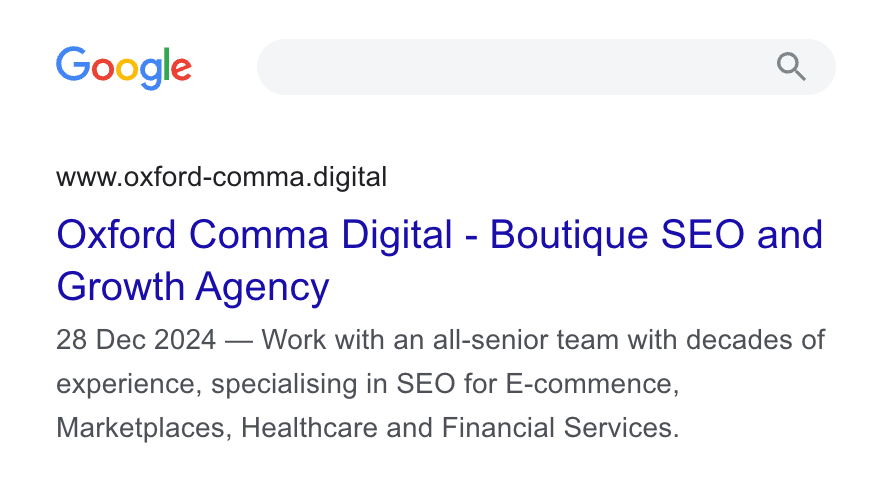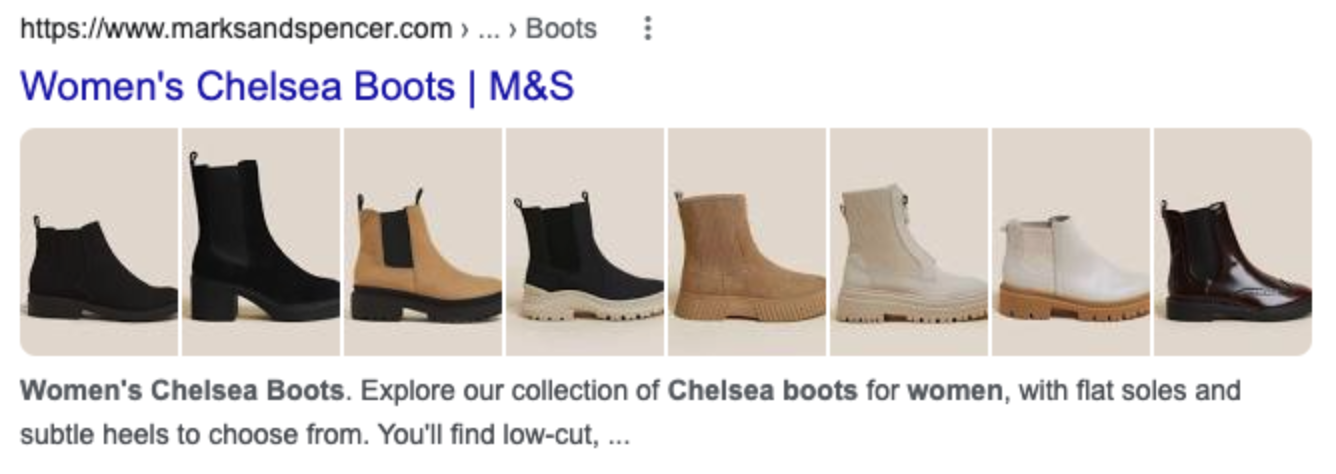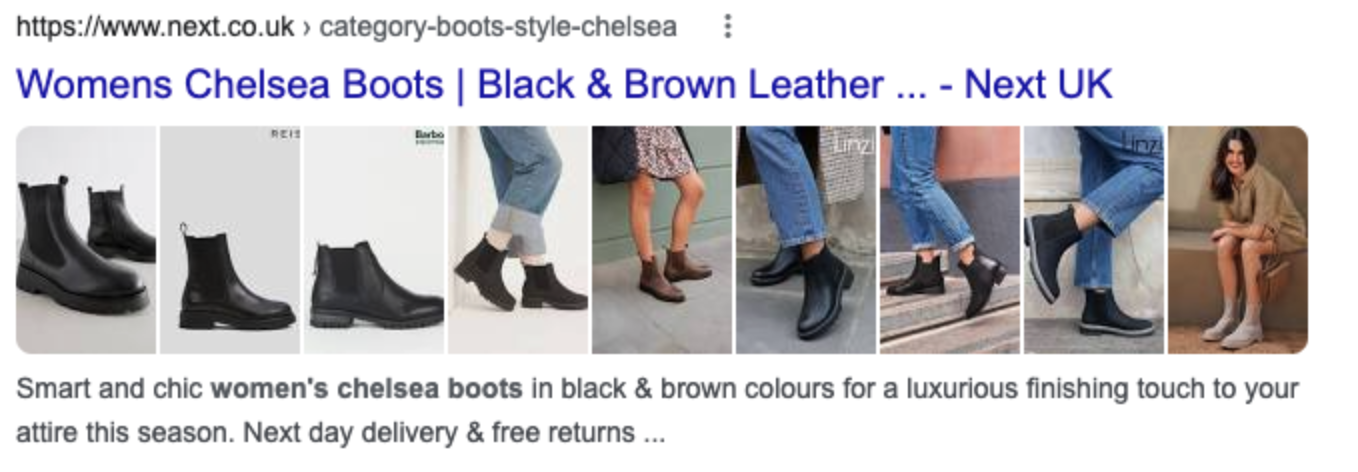The Ultimate Guide to E-commerce Page Titles

Hello and welcome to our ultimate guide on page titles for e-commerce websites! Together we’ll explore what a page title is and why it’s useful, and how to write a great page title for e-commerce. First things first though…
What is a page title?
A page title appears when you use Google, Bing, or another search engine and get a result page back. It’s usually the blue headline from a result listed on that page and looks a bit like this:

But where does this text come from? Well, like anything on a website, it’s a piece of code. This specific snippet sits in the head of your site. Since it acts as a title to introduce your webpage and appears in search engines like this, that snippet of code is called a title tag.
Anything that sits in the head of a website isn’t visible on the website itself, it’s purely for search engines and other bots to understand more about the web page and to display this information in search engine results pages or in the tab, as you can see above. It can also appear in social media, when you share a link, though there’s another tag, called og:title, which will override this.
In most content management systems you’ll have an input field where you can edit the page title, though it’s also sometimes also known as an SEO title or a meta title.
Why are page titles important?
Page titles are a great way to convey to your audience, whether they’re shopping, looking for information or trying to find your homepage, what it is they can expect from your content. Google will pull this information out from your site code and display it directly in search engine results pages, as we saw in the example above.
So it’s really a good idea to put some time and effort into them, since they can massively impact your click-through rates.
What are the best practices for page titles?
There are some best practices that it’s always good to pay attention to, whatever your website deals in.
Ensure your page title is 50-60 characters in length
Best practice for page titles is to have them between 50-60 characters or up to 580 pixels. This is only a best practice, for instance, you could have a very short title of only 10 characters or a very long title of 100 characters, but there are reasons for the choice of 50-60 characters.
If your title is less than 50 characters, that’s typically a sign that there’s not enough detail or something’s missing like your brand name. If it’s over 60 characters then search engines will end up truncating the result, meaning people won’t see a completed message. In the example below, we can see that truncation in action.

This is an example of a small page title:

Recycle Now as a page title only makes sense with additional context. It’s the brand name, so this does make sense for the page title, however, what if I don’t have that initial knowledge? I find out by looking at the domain name above, but as someone skimming through results, am I really going to be looking at that? Without that knowledge, it seems like more of a direction than a brand home page. I’m also lacking any other information about the company, so I have no idea what to expect when landing on the page. It could be a waste of time, I don’t know and am I going to risk that? Probably not. Honestly, I didn’t even click it when writing this article.
To the point
Because you have character limitations you’ll need to write everything in a concise way, you can’t add waffle or fluff if you only have 50 characters to draw in your audience with your USP in an emotive way and also add your brand name.
Include your brand name
This leads me to another best practice, which is to include your brand name.
There are a few reasons why the top spot doesn’t get 100% of the clicks from SERPs, one is the offer isn’t enticing enough or it doesn’t quite match the user’s needs, another is brand recognition. You can use your brand name in page titles to appear in search engine results pages to both increase your brand recognition and to capitalise on it.
When adding your brand name, this is typically done by separating it off from the main page title with a pipe, for example:

However, you can also use a colon or a dash. The pipe is a favourite, however, as it gives some distinction between the brand name and main message but also doesn’t take up too many pixels.
Use your target keyword
This is where some classic SEO comes in. SEOs look at what people are searching on Google for, or what people need and determine what content it would be best to create with that search demand in mind. For example, if you’re an e-commerce company selling hiking gear, including jackets, and there’s 590 searches for these each month, it’s a good idea to create a category page for these. Then to help that content to rank well, you’d need to make sure search engines understand that content is a product listing page dedicated to hiking jackets. One such way to alert both search engines and your audience to the topic of the page is to make sure that target keyword and overall topic of the page is included within the page title.
How to create a great page title for e-commerce:
Those were the general rules around how to create a page title that looks good in search engine results pages, but there are other recommendations that will make that title stand out.
Mirror the language of your audience
This is an extension of using your target keyword. I like to recommend mirroring the language of your users because sometimes there’ll be a technical term for something but your audience will use the colloquial term and won’t be familiar with the technical term. Or if your audience is looking for “How to clean leather boots”, you can mirror that directly in your page title, since it’s exactly what they’re looking for. Overall, this is an extension of the general aim to meet your audience where they are and that includes using the language they use.
Be descriptive
This doesn’t mean adding a lot of adjectives to describe your product. It means properly and fully conveying what that audience can expect if they click through to your site. For product pages, for example, this is typically the name of the product, as long as it’s not too long. Typically, by default, you’ll have a rule in your ecom platform where the page title for your product pages is {Product Name} | {Brand Name}.
Include your unique selling point
Adding a unique selling point for your item in your meta title can be a great way to get interest from SERPs that drives clicks. This can be a tricky one to add to a page title because you don’t have a massive amount of space, but if you can fit it in there, this is a great place to add it. If not, there’s also space in the meta description!
Ensure your title is unique
It’s important that your page titles are unique to you and unique across the site wherever possible. There are, of course, instances where the page title will be the same between two pages of your e-com site, for example, if you have parameterised pagination for product listing pages, then you’ll have duplicate page titles and in this instance it’s not a problem at all. However, wherever you have a unique page, you’ll need a unique page title.
If you find that you have duplicate page titles for two pages, either these pages are too similar or the meta titles aren’t properly descriptive and unique to the content.
Provoke emotions
You could also call this enticing, essentially something that elicits an emotion that makes the user want to find out more. This is tricky to do in the character limits, so again, can be done in the meta description. A good example of this comes from the automotive industry:

Here, Mitsubishi have added their key slogan to the page title, and, typical of this industry, it’s emotive.
Typical page title format
Taking all of this into account, you’ll typically see page titles in these kinds of format:
{Primary Keyword} | {Brand Name}
Here’s one in the wild:

And if you have space:
{Primary Keyword} | {Secondary Keyword} | {Brand Name}

A quick note on the above, there is truncation there but Next likely has a rule where if the first section is too long, truncate it and include the brand name. This ensures their brand name is always visible in SERPs and this is a good way to go for product pages, as sometimes product names can be very long!
If you want to include a slogan, something emotive or a USP:
{Primary Keyword & Brand Name} | {Emotive Slogan} or a switched around version


